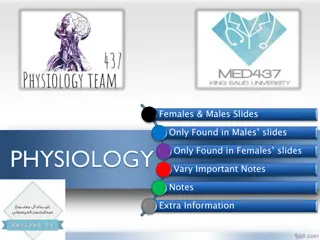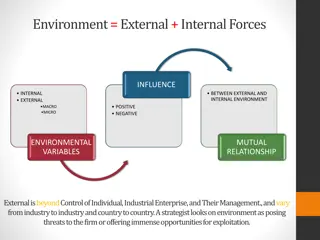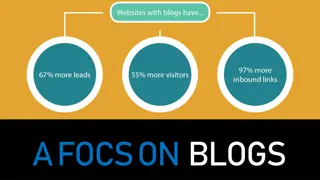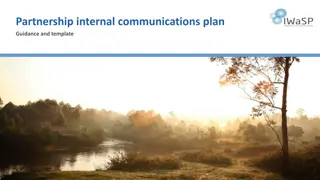Professional Uses of Blogs in Internal Communication
Blogging has evolved beyond personal use to become an effective tool for internal communication within organizations. Professionals are leveraging blogs to communicate with employees, share company information, gather suggestions, and receive employee feedback. Explore the benefits and challenges of using blogs, along with essential aspects to consider when creating and managing a corporate blog. Discover the impact of internal blogs on organizational communication, collaboration, and employee engagement.
Download Presentation

Please find below an Image/Link to download the presentation.
The content on the website is provided AS IS for your information and personal use only. It may not be sold, licensed, or shared on other websites without obtaining consent from the author.If you encounter any issues during the download, it is possible that the publisher has removed the file from their server.
You are allowed to download the files provided on this website for personal or commercial use, subject to the condition that they are used lawfully. All files are the property of their respective owners.
The content on the website is provided AS IS for your information and personal use only. It may not be sold, licensed, or shared on other websites without obtaining consent from the author.
E N D
Presentation Transcript
Student Name School Name Date
Professional Uses of Blogs Blogging has begun to branch out from just the personal uses, but now an effective way in internal communication in the organization. Merriam-Webster officially adopted blog into the dictionary in 2004. a website that contains an online personal journal with reflections, comments, and often hyperlinks provided by the writer (Kelleher, Miller, 2006). More and more Professionals are turning to blogging to communicate with employees, the organization, and can communicate with the public. Other uses includes: News Update, Company Information, Suggestions, Employee Feedback etc.
Pros and Cons of Using Blogs Participation from Employees Collaboration Free Discussion of Issues Collective Intelligence Direct communication between the members of the organization Providing a sense of community Misunderstood statements Too much confidential information could be shared Holding employees accountable Employees might get carried away with communicating to other employees
Challenges In Creating Blogs Before creating there are several questions and challenges the executive must handle: The perfect corporate blog advances in an air of trust where publications don't feel scared or smothered. Be that as it may empowering openness while demoralizing harming comments is an extremely troublesome tightrope to walk. Security is one of the utmost problems that can be challenging to organizations. A lot of people extensive organizations have stopped blogs on the grounds that the environment of genuineness welcomes legitimate problems. The number one reason that organizations of each size don't have a blog is super fear
Aspects to Consider when creating Blogs What's the purpose behind the blog? What norms and rules are set up for posting? What are the punishments for damaging those principles? Who gets to post? Executives, division heads, or everyone? Will you oblige workers to watch the blog, or treat it as a supplemental asset? Should you set breaking points, for example, length of time, timing or recurrence on the amount time workers can use perusing the blog? Should you set rules on the kind of dialog on the blog?
Impact and Managerial Learning Experience Internal Blogs are used to increase organizational communication Increase collaboration Blogs gives employees the ability to open up, when they wouldn t otherwise do it in a face to face conversation. Blogs can work better than just sending out emails-because more people will be aware to provide input, suggestions, or feedback on important subjects in the organization. Learning Sharing: Blogs are an approach to impart mastery on particular themes and are particularly helpful to representatives included in specialized zones obliging forefront data. Venture Management: While there are unquestionably more far reaching approaches to oversee ventures few are as easy to use as blogs, which permit allies to archive an extend, its advancement, its triumphs and difficulties, and lessons learned. Wide Communication among Teams and Across Sites: The imparted blog space permits clients to create one another's thoughts, response inquiries, and explain confuses. Venting: Better out in the open than at the water cooler possible.
Gordon, S. (2006). Rise of the Blog. IEEE Review, 52(3), 32-35. Kelleher, T. and Miller, B. (2006), Organizational Blogs and the Human Voice: Relational Strategies and Relational Outcomes. Journal of Computer-Mediated Communication, 11: 395 414. doi: 10.1111/j.1083- 6101.2006.00019.x Moyer, Jennifer. (2011). Employee / Organizational Communications. Institute for Public Relations. Retrieved from http://www.instituteforpr.org/employee- organizational-communications/























